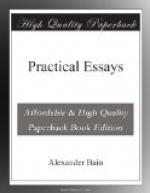[MATTER AND VOID SUPPLEMENTARY.]
While all our senses and feelings give us time, it is our experience of Motion and Resistance,—the energetic or active side of our nature alone,—that gives us Space. The simplest feature of Space is the alternation of Resistance and Non-Resistance, of obstructed motion and freedom to move. The hand presses dead upon an obstacle; the obstacle gives way and allows free motion; these two contrasting experiences are the elements of the two contrasting facts—Matter and Space. By none of the five senses, in their pure and proper character as senses, can we obtain these experiences; and hence at an earlier stage of inquiry into the mind, when our knowledge-giving sensibilities were referred to the five senses, there was no adequate account of the notion of Space or Extension. Space includes more than this simple contrast of the resisting and the non-resisting; it includes what we call the Co-existing or Contemporaneous, the great aggregate of the outspread world, as existing at any moment, a somewhat complicated attainment, which I am not now specially concerned with. It sufficiently illustrates the limitation of our knowledge by our sensibilities, from the nature of space, to fasten attention on the double and mutually supplementing experience of Matter and Void; the one resisting movement, and giving the consciousness of resistance, or dead strain, the other permitting movement, and giving the consciousness of the unobstructed sweep of the limbs or members. Whatever else may be in space, this freedom to move, to soar, to expatiate (in contrast to being hemmed in, obstructed, held fast), is an essential part of the conception, and is formed out of our active or moving sensibilities. Now, as far as movement is concerned, we must be in one of two states;—we must be putting forth energy without effecting movement, being met by obstacles called matter; or we must be putting forth energy unresisted and effecting movement, which is what we




